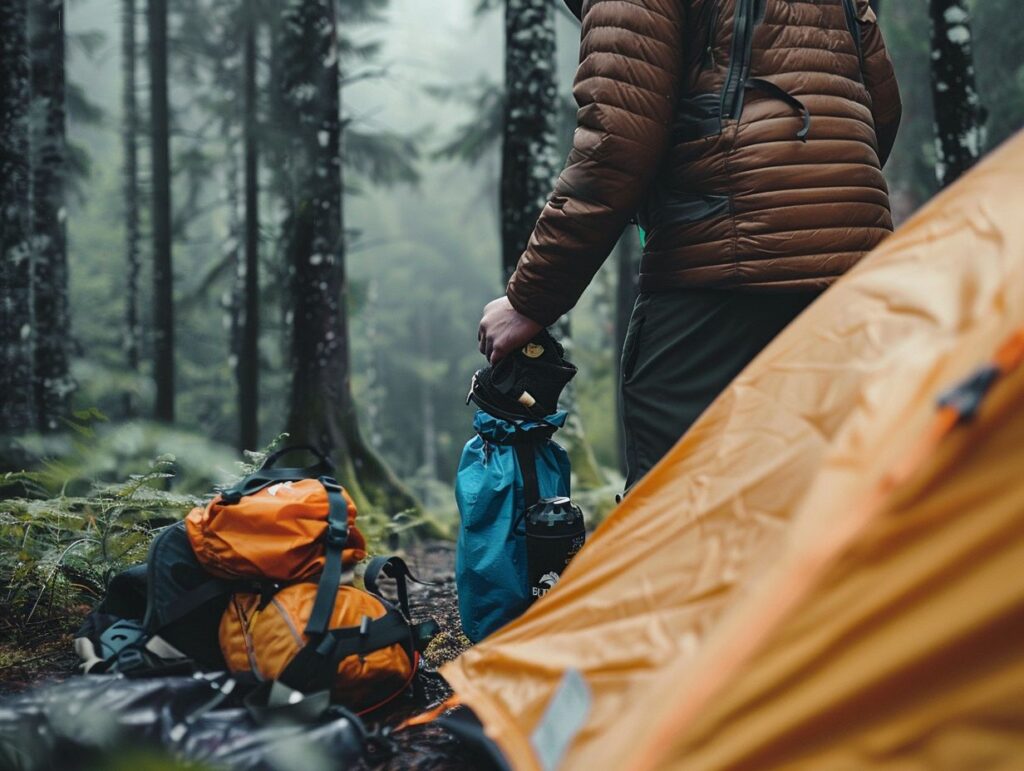Are you ready to embark on an exciting camping adventure but not sure where to start? In this step-by-step guide, we will walk you through everything you need to know to prepare for a successful camping trip.
From determining your camping style and choosing the perfect destination to planning your activities and packing your gear, we’ve got you covered. So grab your tent, sleeping bag, and sense of adventure, and let’s get started on planning the ultimate outdoor getaway!
Key Takeaways:
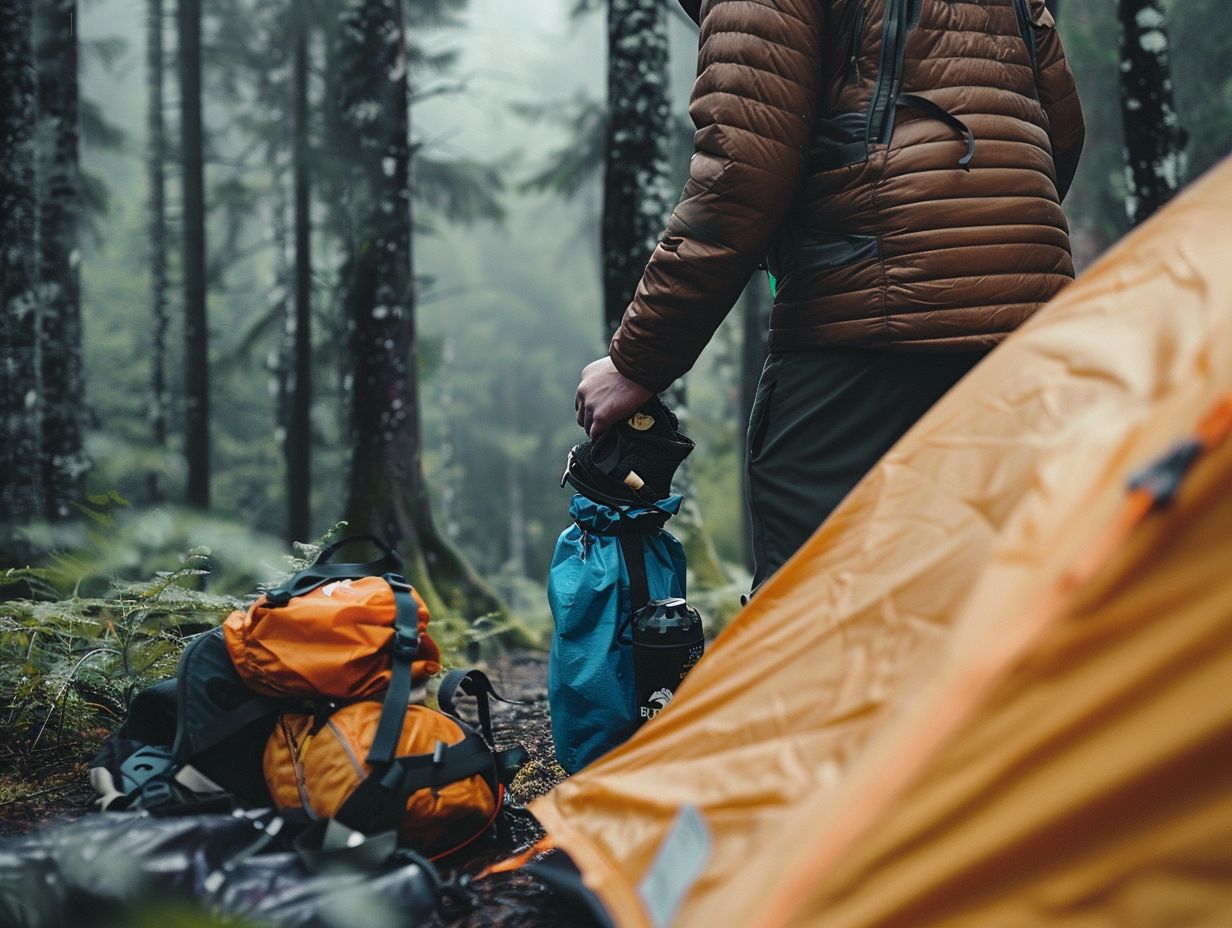
- Determine your camping style and goals to plan your trip effectively.
- Research and choose a suitable camping destination based on terrain and desired amenities.
- Make a checklist of essential items and gather appropriate gear for camping activities and meals.
Step 1: Determine Your Camping Style
The initial critical step in organising a memorable camping trip and guaranteeing a fulfilling experience is the identification of one’s camping style.
Camping styles encompass a wide spectrum, ranging from backpacking in isolated wilderness locations to embarking on road trips with a well-equipped van. Each style necessitates distinct gear and levels of preparatory measures.
What Type of Camping Do You Prefer?
The selection of camping style is essential for maximising enjoyment during outdoor activities, whether it involves setting up a tent in a peaceful forest, travelling in a compact van, or trekking through rugged landscapes.
Tent camping provides a straightforward experience and establishes a direct connection with the natural environment, allowing individuals to fall asleep to the serene sounds of the wilderness. Conversely, van camping offers the advantages of mobility and comfort, providing a convenient shelter at any location.
Backpacking, while demanding, delivers a genuine sense of adventure as individuals carry all necessities on their back, fully immersing themselves in the journey. Each camping style possesses its own distinct charm and caters to varied preferences, ranging from individuals seeking a quiet retreat to those desiring a thrilling expedition.
What Are Your Camping Goals?
Establishing specific camping objectives is crucial in tailoring your trip to align with your distinct preferences, whether your aim is relaxation, adventure, or cultivating a profound connection with your selected destination.
By contemplating the type of experience you genuinely desire, you can opt for a camping style that resonates with your aspirations. Should you yearn for tranquillity and a sense of calm, a peaceful campsite nestled amidst natural surroundings could be the ideal selection.
For individuals seeking new challenges and excitement, embarking on a backcountry expedition may provide the adventurous experience desired. Conversely, if your interest lies in learning about local flora and fauna, a visit to a national park with curated educational excursions might be the preferred option.
Your camping objectives serve as a guiding compass directing you towards the experience that best aligns with your desires.
Step 2: Choose Your Camping Destination
Selecting the appropriate camping destination is essential to ensuring a rewarding and enjoyable trip. With a variety of beautiful locations such as the Pacific Northwest, Southwest Colorado, and Arizona, choosing a destination that aligns with your camping goals and preferences is paramount.
What Type of Terrain Do You Want?
The preference for a particular type of terrain can significantly impact one’s camping experience, whether they are attracted to the rugged allure of mountains, the peaceful ambiance of forests, or the expansive views of deserts typically found in various National Parks.
Each type of terrain presents its own distinct challenges and rewards for outdoor enthusiasts and campers.
- Mountainous regions, characterised by steep slopes and high elevations, offer a profound sense of achievement upon reaching the peak.
- Forests, featuring dense canopies and diverse wildlife, provide a tranquil setting for individuals seeking solitude and calm.
- Deserts, known for their extreme temperatures and limited vegetation, challenge one’s survival skills while offering unparalleled opportunities for stargazing.
- Coastal areas, showcasing crashing waves and sandy shores, offer a unique setting for seaside camping, blending relaxation with adventurous experiences.
What Amenities Do You Need?
Determining the amenities required at one’s campsite is essential for planning a comfortable and enjoyable camping expedition. Whether basic necessities such as water and toilets are adequate, or more luxurious offerings like showers and electricity are preferred, careful consideration is vital.
When selecting a campsite, the importance of amenities like fire pits for cooking and evening get-togethers, picnic tables for dining convenience, and effective rubbish disposal systems for maintaining cleanliness should be considered.
Access to hiking paths, fishing spots, or swimming areas can enhance the outdoor experience. Striking a harmonious balance between essential amenities and a more rustic camping experience is crucial.
Embracing certain inconveniences, such as the lack of Wi-Fi or choosing basic shelters instead of fully-equipped cabins, can add a touch of adventure and authenticity to the camping trip.
Step 3: Plan Your Camping Activities
The strategic organisation of camping activities is essential for maximising the enjoyment of outdoor adventures.
Whether individuals prefer activities such as hiking with provisions, exploring the extensive trail networks overseen by the US National Park Service, or simply engaging in leisurely lakeside relaxation, the development of a meticulously planned itinerary can significantly elevate the overall camping experience.
What Activities Do You Want to Do While Camping?
Selecting the activities in which one wishes to partake whilst camping can significantly enhance the overall outdoor experience. Whether it involves trekking picturesque trails, savouring meals by a campfire, or participating in water-based sports, these activities can add depth to the camping trip.
Exploring renowned trails such as the Appalachian Trail or the Pacific Crest Trail provides a distinct opportunity to fully immerse oneself in the splendour of nature whilst also presenting a physical challenge.
Furthermore, campfire cooking introduces a delightful element to the camping expedition. It enables individuals to enjoy delicious meals prepared over an open flame, fostering camaraderie through shared stories with fellow campers.
Additionally, engaging in activities such as fishing, canoeing, or stargazing can further enhance one’s connection with the natural environment, leaving behind lasting memories of the experience.
Do You Need to Bring Special Equipment?
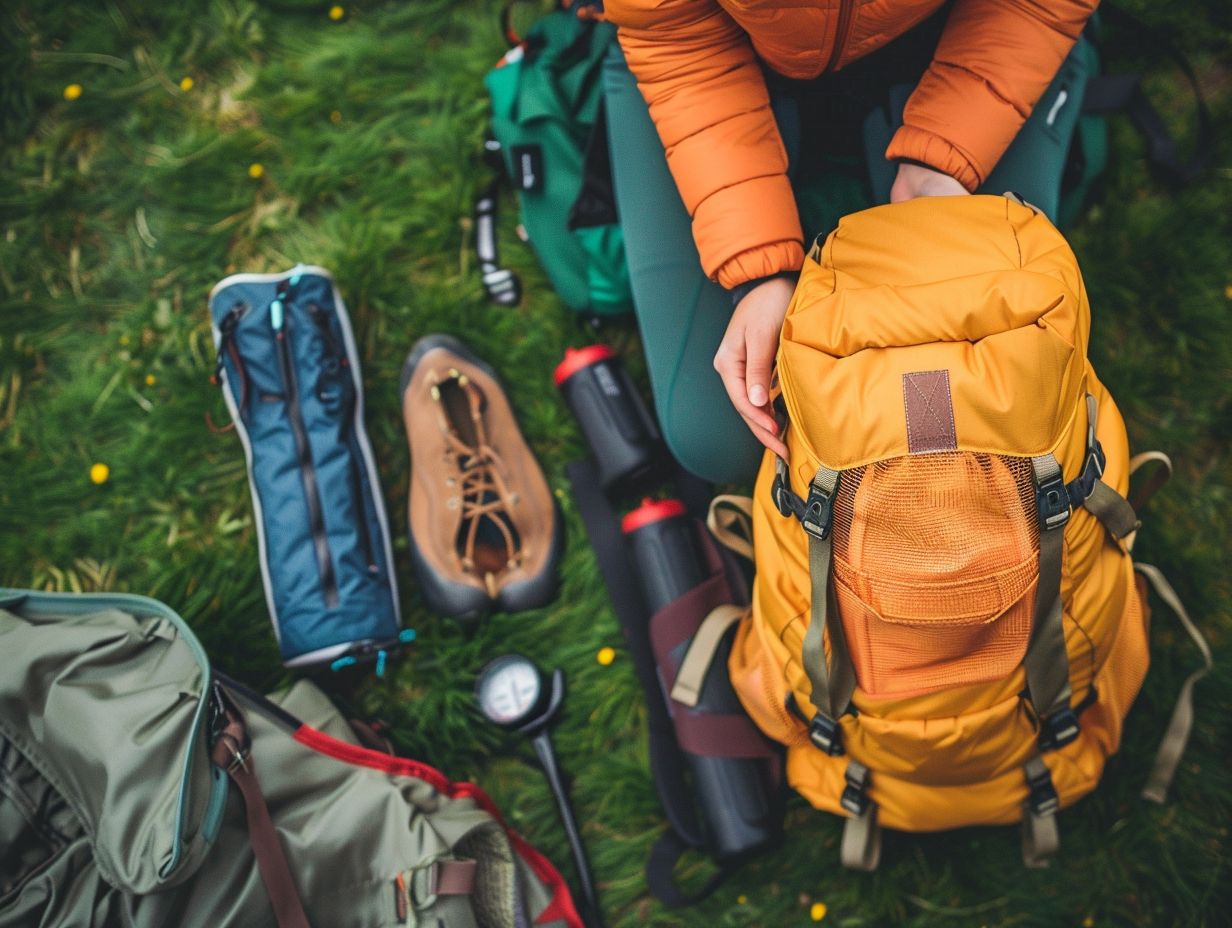
Proper selection of specialised equipment is imperative for various camping activities, particularly activities like backpacking that demand specific gear and meticulous planning.
For any outdoor endeavour, whether tackling a challenging hike or engaging in fishing along a riverbank, the significance of appropriate equipment cannot be overstated. Essential tools such as hiking boots offering adequate ankle support and traction, a durable fishing rod, or climbing gear suited to the terrain are essential for different activities.
When preparing for outdoor excursions, it is crucial to factor in weight and space constraints to ensure that all necessary equipment is included without causing an excessive burden. Conducting thorough research into the distinct requirements of the chosen activity and location can facilitate efficient packing and better equip individuals to confront any obstacles that may arise.
Step 4: Make a Camping Checklist
Developing a thorough camping checklist is a crucial component in ensuring that all necessary items are accounted for during a camping trip. Sufficient preparation and careful organisation can reduce last-minute stress and ensure that the outdoor adventure is approached with complete readiness.
What Essential Items Do You Need?
Indispensable components for camping encompass essentials such as a sleeping bag to facilitate a restful night’s sleep, a tarp for supplementary shelter, and additional requisites to ensure the safety and comfort of campers.
Another pivotal inclusion for camping expeditions is a dependable camping stove. This apparatus enables individuals to prepare hot meals, boil water for beverages, and furnishes warmth during colder evenings. The presence of a portable water filter is imperative to guarantee a clean water source for consumption and culinary purposes.
Furthermore, a high-calibre camping knife proves invaluable for cutting rope, meal preparation, and various other tasks. The collective possession of these items contributes significantly to the realization of a successful and gratifying camping venture.
What Optional Items Do You Want to Bring?
Supplementary items can enhance one’s camping experience by providing additional comfort and entertainment amenities, such as portable chairs, games, and extra cooking apparatus.
- Portable chairs provide a comfortable space for relaxation near the campfire, while engaging in games such as cards or frisbee can encourage enjoyable moments with companions.
- Moreover, additional cooking equipment, such as a portable barbecue or camping stove, allows individuals to embark on culinary adventures amidst the natural surroundings.
- The inclusion of a hammock offers a peaceful break under the canopy of trees, while the presence of a portable speaker can create a harmonious atmosphere.
These items cater to a varied range of preferences, accommodating individuals looking for both a relaxed camping trip and those wanting a more active outdoor experience.
Step 5: Gather Your Camping Gear
It is imperative to obtain the appropriate camping gear to ensure a comfortable and enjoyable trip. Whether one needs a sturdy tent, insulated sleeping bags, or reliable cooking supplies, having the right equipment can greatly influence the overall camping experience.
Tents, Sleeping Bags, and Other Shelter
The selection of appropriate tent, sleeping bags, and sleeping mats is crucial for ensuring a restful and comfortable night’s sleep during camping.
In determining the tent type, it is imperative to evaluate the specific camping requirements. For backpacking expeditions, the ideal choice is a lightweight and compact tent, such as a single-skinned or freestanding variety. These tents are known for their ease of setup and portability.
Conversely, in the case of family camping, a larger cabin-style tent offering ample space for multiple sleepers and equipment may be more suitable. The selection of the correct sleeping bag and mat is dependent on the expected temperature and desired comfort level.
It is advisable to opt for a sleeping bag with a suitable temperature rating and insulation type, accompanied by a comfortable sleeping mat to provide additional cushioning and warmth.
Cooking and Food Supplies
Cooking and food supplies are integral elements of one’s camping equipment, ensuring the ability to prepare nutritious and satisfying meals, ranging from uncomplicated trail mix snacks to elaborate campsite dinners. Bringing essential items such as tinned beans, rice, and pasta can serve as the foundation for a variety of meals.
It is advisable to include spices, olive oil, and vinegar to enhance the flavours of these dishes. Additionally, considering easy-to-prepare proteins such as tinned tuna or smoked sausages can contribute to the creation of quick and substantial meals.
To facilitate meal preparation during camping trips, it is recommended to pre-chop vegetables at home and store them in airtight containers.
Furthermore, for effective storage of perishable items, the acquisition of a high-quality cooler is advisable to maintain freshness. The utilisation of straightforward camping recipes like foil parcel meals or one-pot dishes can simplify the cooking process in an outdoor setting.
Clothing and Personal Items
It is essential to carefully select appropriate clothing and personal items to ensure adaptability to fluctuating weather conditions and guarantee personal comfort throughout the camping expedition.
When planning your camping activities, such as hiking, fishing, or leisurely campfire gatherings, take into account the prevailing temperatures. In warmer weather conditions, opt for lightweight and breathable attire like moisture-wicking t-shirts, shorts, and a sun hat.
Conversely, in colder climates, layering becomes imperative; include thermal shirts, a fleece jacket, and a waterproof outer layer in your packing list. Additionally, do not overlook vital gear such as sturdy hiking boots, sunglasses, and a reusable water bottle.
To optimise packing space and maintain organisation, employ the technique of rolling clothes instead of folding them. Furthermore, utilise packing cubes to segregate items based on categories, facilitating easy access to essential belongings.
Step 6: Plan Your Meals
Careful meal planning is essential for a successful camping trip. It ensures that you have the necessary ingredients and cooking utensils to make satisfying meals, whether it’s a simple peanut butter sandwich or a full meal cooked over an open fire.
What Foods Can You Bring?
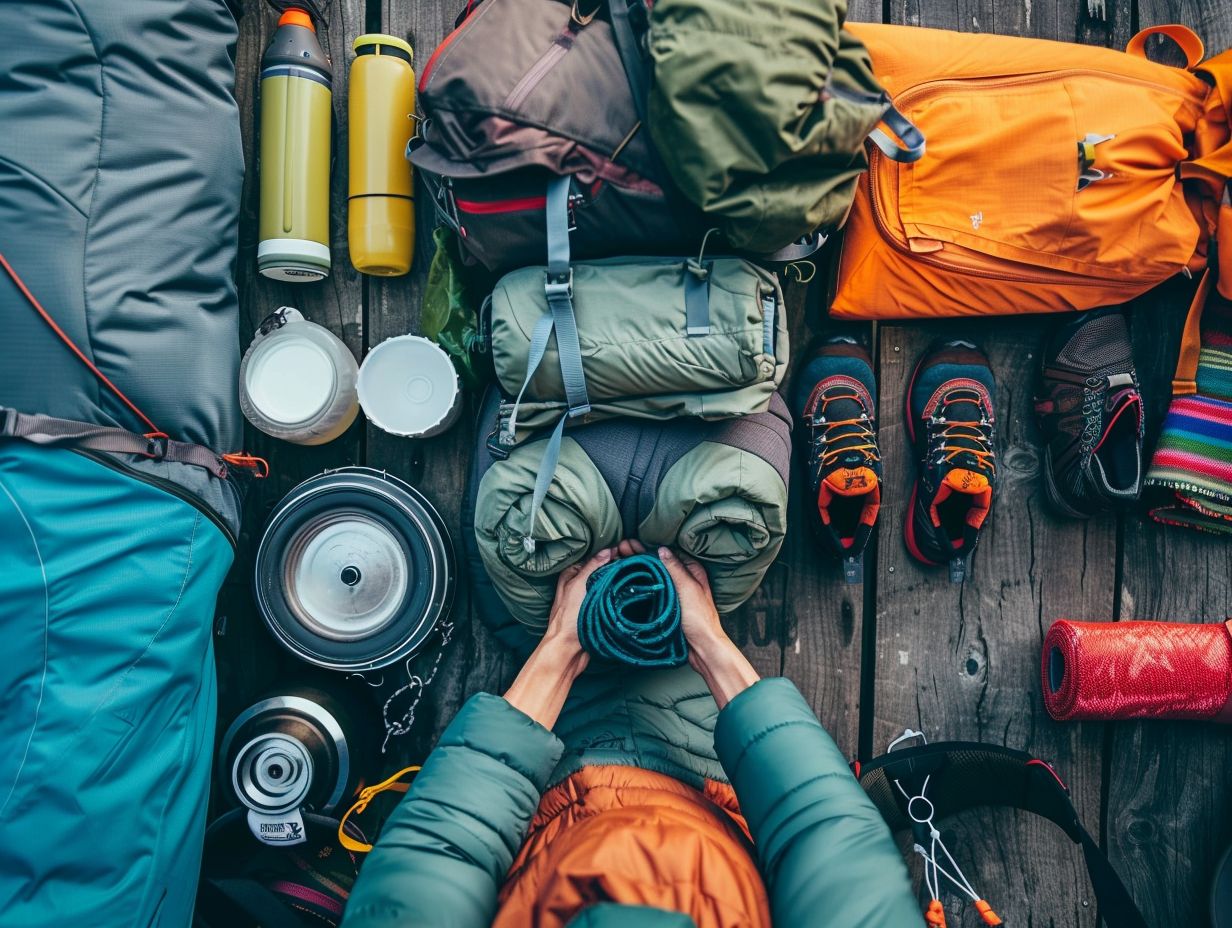
Choosing the appropriate food items to bring along on a camping excursion, specifically non-perishable selections such as trail mix and peanut butter, is essential for ensuring the availability of convenient and nutritious sustenance throughout the trip.
Non-perishable food items are particularly well-suited for camping endeavours due to their ability to remain unspoilt without the need for refrigeration, facilitating ease of packing and storage. Dried fruits, canned beans, and energy bars are examples of lightweight options that offer essential nutrients.
To optimise packing efficiency, it is advisable to select individual servings or resealable packages to reduce waste and maintain organisational order. Including a variety of sweet and savoury choices in the selection can cater to different taste preferences while on the move.
These food items not only offer convenience but also contribute to sustaining energy levels during outdoor excursions.
What Foods Can You Cook on Site?
The preparation of meals directly on the campsite, particularly utilising a campfire, can prove to be one of the most enjoyable aspects of the camping experience. This method allows individuals to craft a wide array of dishes ranging from simple hot dogs to elaborate gourmet cast iron creations.
To achieve success in campfire cooking, it is imperative to possess the appropriate equipment. A durable cast iron skillet stands out as a versatile tool suitable for searing meats or preparing substantial breakfast meals. Essential long tongs should not be overlooked, as they facilitate the safe flipping and handling of food over the open flames.
For more delicate food items such as fish or vegetables, a grilling basket can significantly improve cooking outcomes. When working with meats, the utilisation of a meat thermometer is recommended to guarantee thorough cooking.
Engaging in thorough meal preparation by organising ingredients in advance can streamline mealtime activities and ensure the contentment of hungry campers.
Step 7: Pack Your Camping Gear
Efficiently packing your camping gear is crucial to ensuring that you are well-equipped for your trip, whilst also maintaining a manageable and organised load.
How to Pack Your Gear Efficiently?
Efficiently packing gear requires meticulous planning and organisation to optimise space and reduce weight, thereby enhancing the comfort and functionality of the camping experience.
An effective initial step is to compile a comprehensive list of essential items required for the camping trip. It is advisable to prioritise items such as clothing, food provisions, shelter, and personal hygiene products.
After finalising the list, it is recommended to utilise packing aids such as compression bags to conserve space. Compression bags are particularly beneficial for expelling excess air, enabling the efficient utilisation of the storage capacity in backpacks or gear bags. This approach facilitates item organisation and prevents shifting during transportation.
What to Pack in Your Daypack?
Ensuring that your daypack is equipped with essential items such as water, snacks, first aid supplies, and navigation tools is essential when setting out on day trips away from your main campsite.
To maintain a balance between weight and accessibility in your daypack, it is advisable to strategically organize your belongings. Placing heavier items like water bottles and tools nearer to your back will help maintain balance. For easy access to snacks and navigation tools, outer pockets can be used.
Opting for lightweight and compact versions of essentials can reduce bulk. Including versatile items like a multi-tool or a head torch, which can serve multiple purposes, is advisable. Also, adjusting straps and ensuring a comfortable fit is crucial to evenly distribute weight, thus reducing strain during day hikes and other activities.
Step 8: Know the Rules and Regulations
Having a thorough understanding of the rules and regulations relating to your chosen camping area is essential to ensure a safe and legal trip. This includes being aware of any required licences, specific regulations applicable to National Parks, or guidelines established by the Bureau of Land Management (BLM).
Are There Any Restrictions or Permits Needed?
Certain camping destinations, particularly renowned National Parks, often mandate permits and impose specific restrictions to conserve natural resources and guarantee visitor safety. These permits generally categorise into two primary classifications:
- Camping permits are typically obligatory for established campgrounds within the park, often implemented to regulate the influx of campers and safeguard the surrounding environment.
- Conversely, backcountry permits are essential for individuals seeking to explore more secluded regions and partake in activities like backpacking or dispersed camping.
To procure these permits, visitors typically must submit applications online or in-person through the park’s official website or visitor centre. It is crucial to familiarise oneself with prevalent restrictions, such as fire prohibitions, bear activity zones, and designated camping areas, to ensure a camping experience that is both secure and conscientious.
What Are the Campground Rules?
Getting to know the regulations of the campsite is vital to enable a smooth and enjoyable camping trip, ensuring strict adherence to rules concerning quiet hours, campfire usage, and waste management. Following these rules not only promotes a peaceful atmosphere for all campers but also plays a crucial role in preserving the natural beauty of the surrounding environment.
By showing respect for quiet hours, campers demonstrate consideration for others looking for a peaceful retreat. Using campfires correctly helps to prevent wildfires and protect the ecosystem. Properly disposing of waste is essential for maintaining cleanliness and reducing the impact on wildlife. These rules are enforced to guarantee the safety and sustainability of the campsite for all its occupants.
Step 9: Leave a Camping Itinerary
It is imperative to leave a comprehensive camping itinerary with a trusted individual as a crucial safety measure. This practice can prove invaluable in the event of an emergency, as it ensures that someone is aware of your plans and can take appropriate action if necessary.
Where Are You Going and When Will You Return?
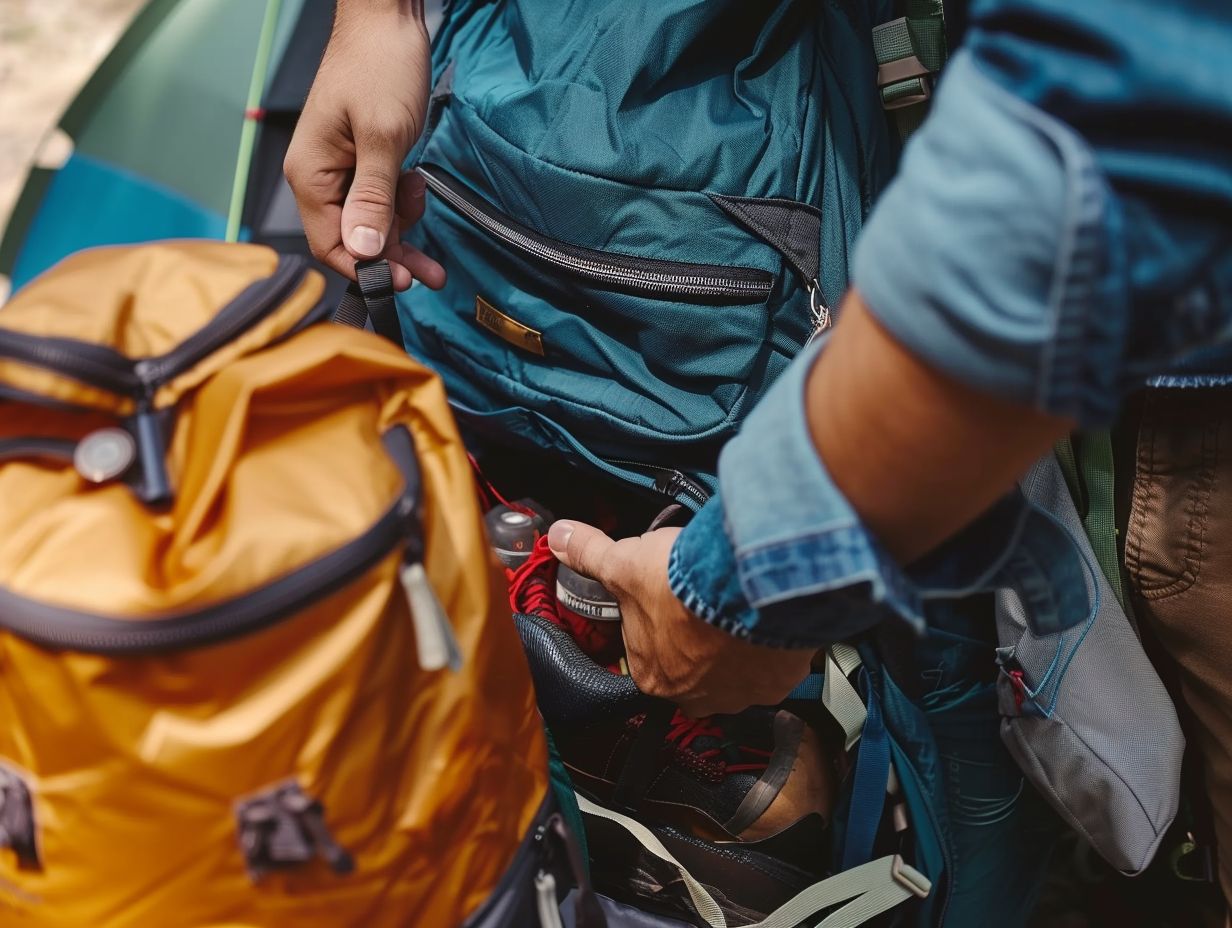
It is recommended to clearly delineate your intended destination and return date within your itinerary to ensure that individuals are aware of your whereabouts and can notify authorities in the event of your failure to return as scheduled.
Additionally, it is advisable to include precise addresses or GPS coordinates for each location you intend to visit, as this information can be vital for emergency responders or support personnel in case of unexpected circumstances. Furthermore, providing contact details for accommodations, local guides, and emergency contacts throughout your journey is highly encouraged.
Furthermore, documenting the dates and times of any scheduled activities or excursions can aid in coordinating assistance if required. By incorporating such detailed information into your itinerary, you not only bolster your safety but also facilitate the ability of others to aid you if the need arises.
Who Should You Notify in Case of Emergency?
Part of an individual’s camping safety strategy is designating and informing a reliable individual in the event of an emergency. This practice ensures that someone is aware of your itinerary and can intervene should an unexpected event occur.
When identifying a suitable contact person, it is advisable to choose an individual who shows reliability, accessibility, and familiarity with your outdoor arrangements. It is vital to disclose critical emergency details such as your exact camping site, planned activities, as well as any existing medical conditions or allergies.
Establishing a clear communication protocol with this designated individual, which includes prearranged check-in intervals and alternative methods of contacting you, is essential. The use of technological tools such as GPS devices or satellite phones can further enhance your ability to maintain connectivity in remote areas.
By taking these precautionary measures, you can significantly improve the safety of your camping trips.
Frequently Asked Questions
What should I pack for a camping trip?
When preparing for a camping trip, it’s important to pack essentials such as a tent, sleeping bag, cooking supplies, food and water, first aid kit, appropriate clothing, and personal toiletries. It’s also a good idea to pack additional items like a map, flashlight, and insect repellent.
How can I plan my meals for a camping trip?
The key to planning meals for a camping trip is to keep it simple. Opt for easy-to-make meals like sandwiches, pasta, and foil-wrapped dishes. Plan out your meals beforehand, make a grocery list, and pack non-perishable items that will last throughout your trip. Don’t forget to bring a cooler for perishable items and pack enough food for each day.
Should I bring a first aid kit on a camping trip?
Yes, it’s important to pack a first aid kit for a camping trip. Accidents and injuries can happen, so it’s better to be prepared with essentials like bandages, gauze, antiseptic wipes, and pain relievers. Make sure to also include any necessary medication or personal medical supplies.
How can I choose a suitable campsite?
When choosing a campsite, consider factors such as nearby amenities, access to water and fire pits, level ground for setting up a tent, and the type of scenery you prefer. Research different campgrounds and read reviews to find the best fit for your needs.
What safety precautions should I take on a camping trip?
It’s important to follow safety precautions on a camping trip to ensure a safe and enjoyable experience. These include being aware of your surroundings, bringing a map and compass, staying hydrated, properly storing food to prevent attracting wildlife, and following campground rules and regulations.
How can I leave the campsite clean and environmentally friendly?
Leave No Trace principles should always be followed when camping to minimise the impact on the environment. This includes properly disposing of waste, not disturbing natural surroundings, and leaving the campsite as clean as you found it. Make sure to also properly put out any fires and avoid using single-use items.

